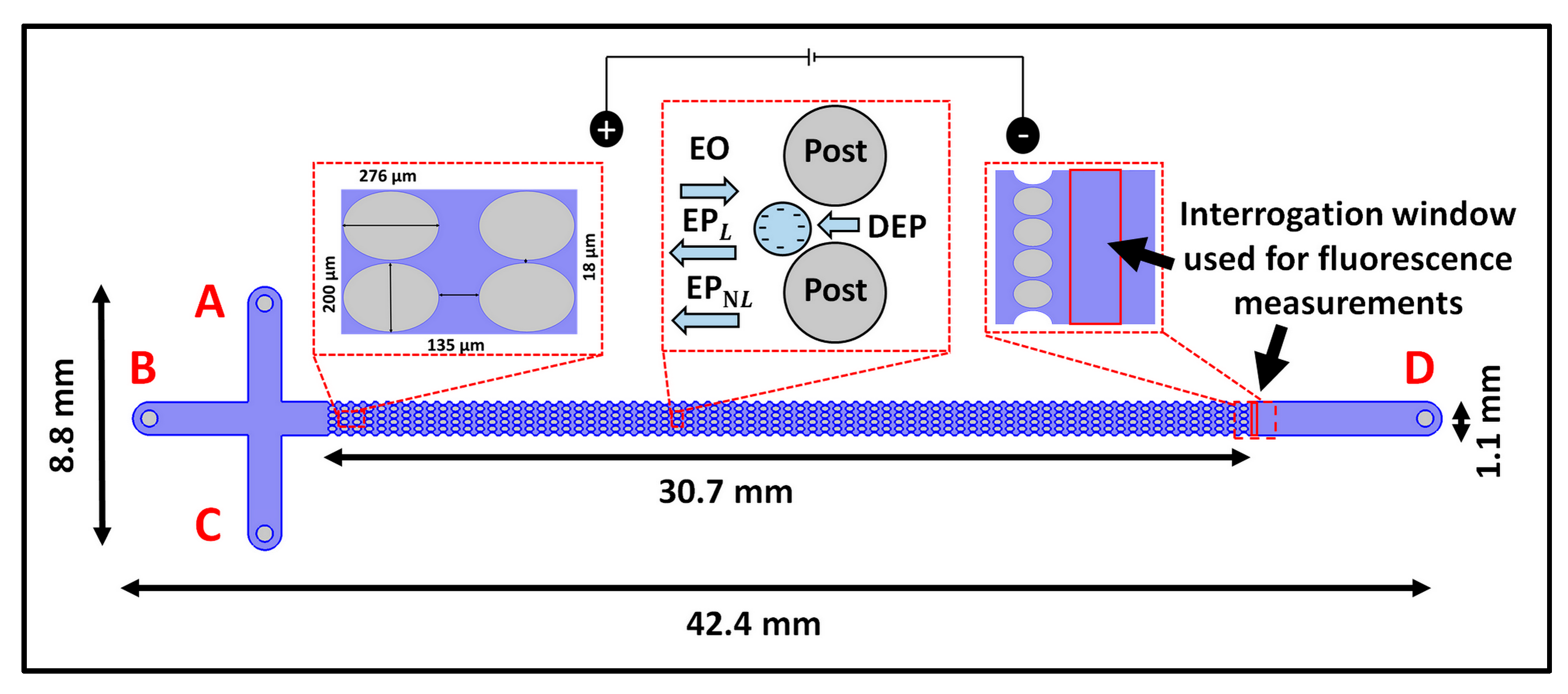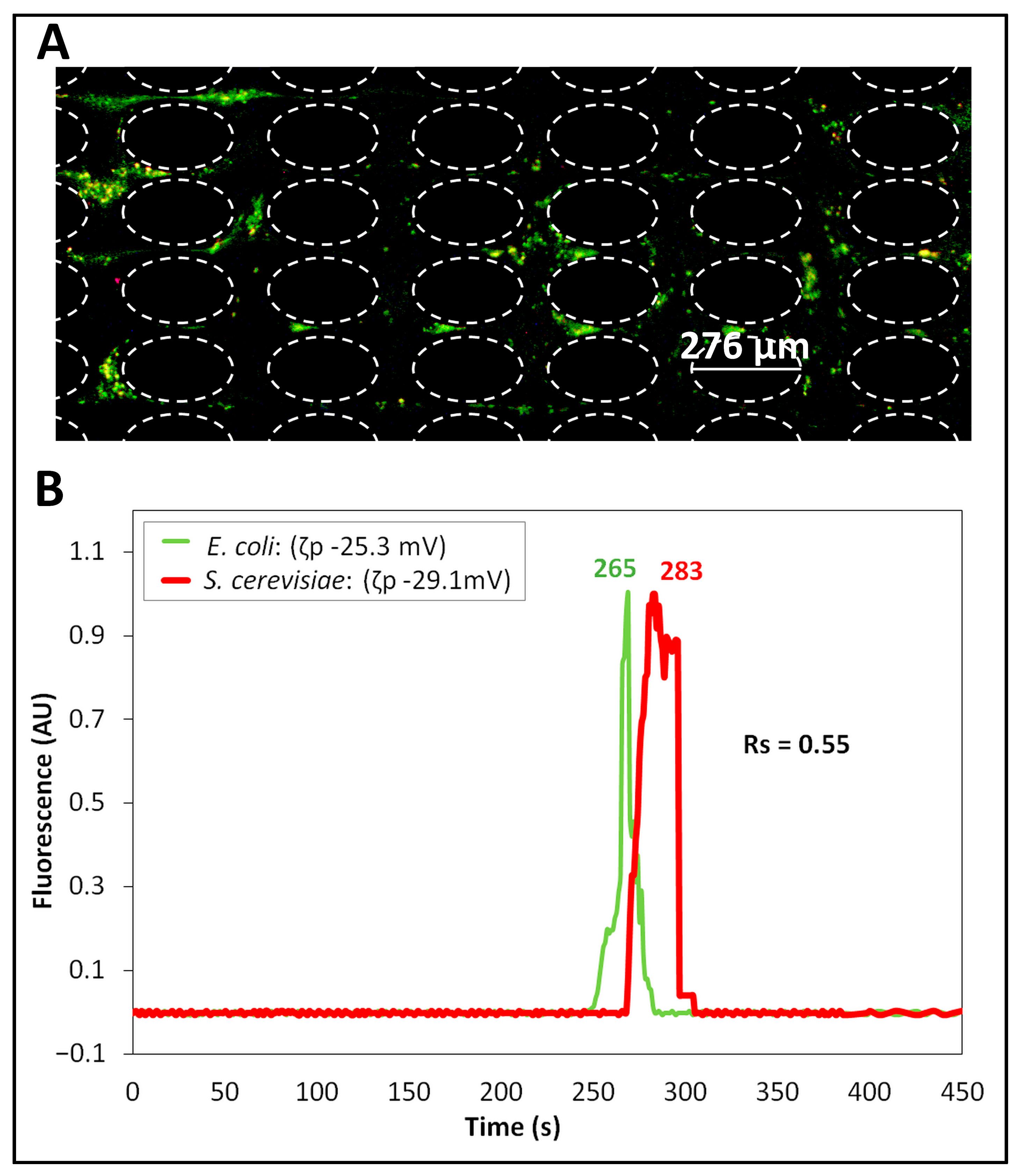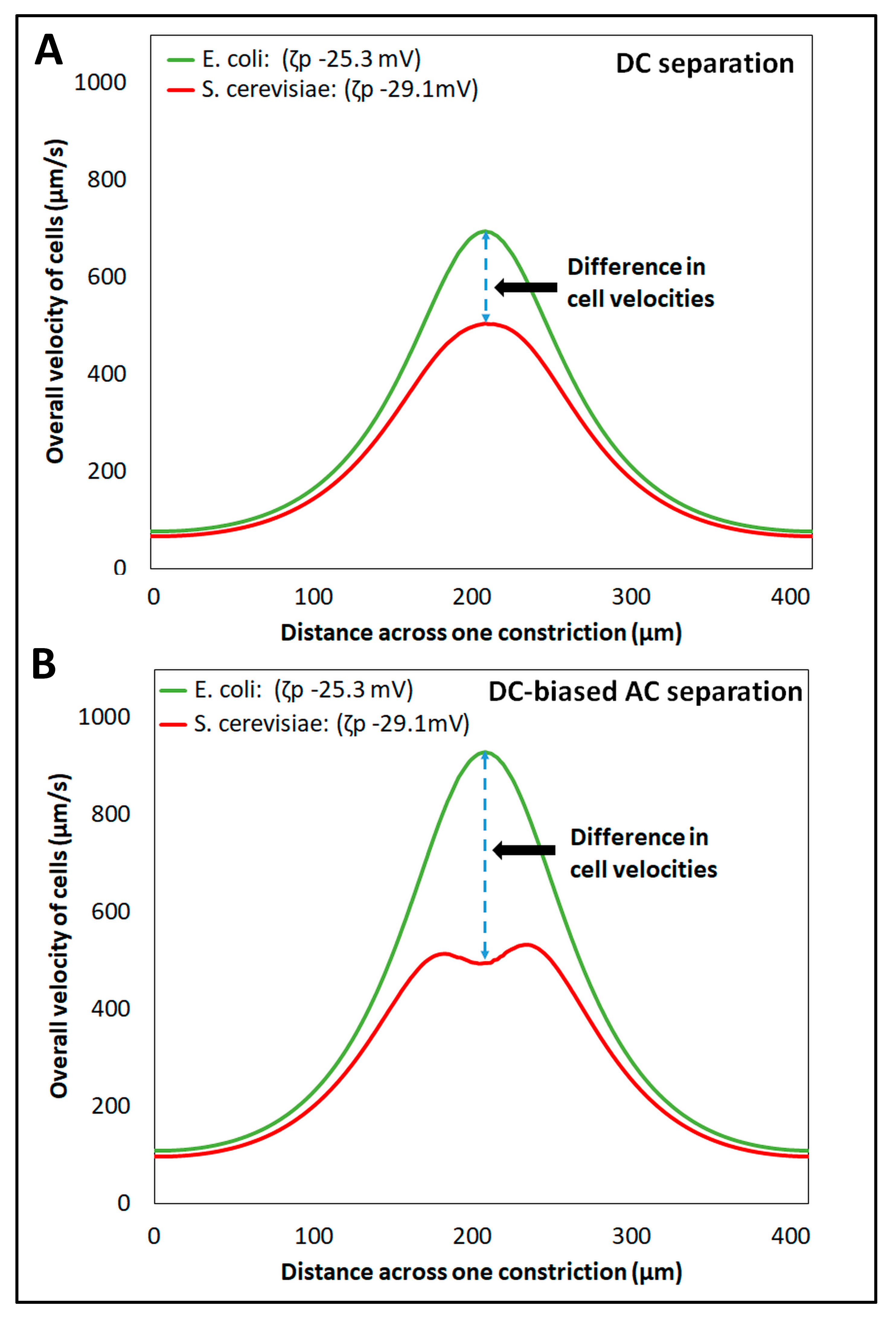Assessing the Discriminatory Capabilities of iEK Devices under DC and DC-Biased AC Stimulation Potentials
Abstract
1. Introduction
2. Theory
3. Materials and Methods
3.1. Fabrication of Microdevices
3.2. Suspending Medium and Cell Samples
3.3. Equipment and Software
3.4. Experimental Procedure
3.5. Mathematical Modeling
4. Results and Discussion
4.1. Separation of Cells by Applying DC Signal
4.2. Separation of Cells by Applying DC-Biased Low-Frequency AC Signal
4.3. Comparison of the Separation Effectiveness Obtained with the DC Voltages and with the DC-Biased Low-Frequency AC Voltages
5. Conclusions
Supplementary Materials
Author Contributions
Funding
Data Availability Statement
Acknowledgments
Conflicts of Interest
References
- Rajapaksha, P.; Elbourne, A.; Gangadoo, S.; Brown, R.; Cozzolino, D.; Chapman, J. A Review of Methods for the Detection of Pathogenic Microorganisms. Analyst 2019, 144, 396–411. [Google Scholar] [CrossRef]
- Dorsey, J.G. Introduction to Modern Liquid Chromatography, 3rd Ed. J. Am. Chem. Soc. 2010, 132, 9220. [Google Scholar] [CrossRef]
- Klepárník, K. Recent Advances in Combination of Capillary Electrophoresis with Mass Spectrometry: Methodology and Theory. Electrophoresis 2015, 36, 159–178. [Google Scholar] [CrossRef]
- Ding, J.; Woolley, C.; Hayes, M.A. Biofluid Pretreatment Using Gradient Insulator-Based Dielectrophoresis: Separating Cells from Biomarkers. Anal. Bioanal. Chem. 2017, 409, 6405–6414. [Google Scholar] [CrossRef]
- Xuan, X. Recent Advances in Direct Current Electrokinetic Manipulation of Particles for Microfluidic Applications. Electrophoresis 2019, 40, 2484–2513. [Google Scholar] [CrossRef]
- Ding, J.; Lawrence, R.M.; Jones, P.V.; Hogue, B.G.; Hayes, M.A. Concentration of Sindbis Virus with Optimized Gradient Insulator-Based Dielectrophoresis. Analyst 2016, 141, 1997–2008. [Google Scholar] [CrossRef]
- Vaghef-Koodehi, A.; Ernst, O.D.; Lapizco-Encinas, B.H. Separation of Cells and Microparticles in Insulator-Based Electrokinetic Systems. Anal. Chem. 2023, 95, 1409–1418. [Google Scholar] [CrossRef]
- Desai, M.J.; Armstrong, D.W. Separation, Identification, and Characterization of Microorganisms by Capillary Electrophoresis. Microbiol. Mol. Biol. Rev. 2003, 67, 38–51. [Google Scholar] [CrossRef]
- Girod, M.; Armstrong, D.W. Monitoring the Migration Behavior of Living Microorganisms in Capillary Electrophoresis Using Laser-Induced Fluorescence Detection with a Charge-Coupled Device Imaging System. Electrophoresis 2002, 23, 2048–2056. [Google Scholar] [CrossRef] [PubMed]
- Rodriguez, M.A.; Armstrong, D.W. Separation and Analysis of Colloidal/Nano-Particles Including Microorganisms by Capillary Electrophoresis: A Fundamental Review. J. Chromatogr. B 2004, 800, 7–25. [Google Scholar] [CrossRef] [PubMed]
- Schneiderheinze, J.M.; Armstrong, D.W.; Schulte, G.; Westenberg, D.J. High Efficiency Separation of Microbial Aggregates Using Capillary Electrophoresis. FEMS Microbiol. Lett. 2000, 189, 39–44. [Google Scholar] [CrossRef][Green Version]
- Armstrong, D.W.; Schulte, G.; Schneiderheinze, J.M.; Westenberg, D.J. Separating Microbes in the Manner of Molecules. 1. Capillary Electrokinetic Approaches. Anal. Chem. 1999, 71, 5465–5469. [Google Scholar] [CrossRef]
- Horká, M.; Karásek, P.; Růžička, F.; Dvořáčková, M.; Sittová, M.; Roth, M. Separation of Methicillin-Resistant from Methicillin-Susceptible Staphylococcus Aureus by Electrophoretic Methods in Fused Silica Capillaries Etched with Supercritical Water. Anal. Chem. 2014, 86, 9701–9708. [Google Scholar] [CrossRef]
- Horká, M.; Šalplachta, J.; Karásek, P.; Růžička, F.; Štveráková, D.; Pantůček, R.; Roth, M. Rapid Isolation, Propagation, and Online Analysis of a Small Number of Therapeutic Staphylococcal Bacteriophages from a Complex Matrix. ACS Infect. Dis. 2020, 6, 2745–2755. [Google Scholar] [CrossRef]
- Horká, M.; Šalplachta, J.; Karásek, P.; Růžička, F.; Roth, M. Online Concentration of Bacteria from Tens of Microliter Sample Volumes in Roughened Fused Silica Capillary with Subsequent Analysis by Capillary Electrophoresis and Matrix-Assisted Laser Desorption/Ionization Time-of-Flight Mass Spectrometry. ACS Infect. Dis. 2020, 6, 355–365. [Google Scholar] [CrossRef]
- Šalplachta, J.; Horká, M.; Růžička, F.; Šlais, K. Identification of Bacterial Uropathogens by Preparative Isoelectric Focusing and Matrix-Assisted Laser Desorption/Ionization Time-of-Flight Mass Spectrometry. J. Chromatogr. A 2018, 1532, 232–237. [Google Scholar] [CrossRef]
- Horká, M.; Šlais, K.; Šalplachta, J.; Růžička, F. Preparative Isoelectric Focusing of Microorganisms in Cellulose-Based Separation Medium and Subsequent Analysis by CIEF and MALDI-TOF MS. Anal. Chim. Acta 2017, 990, 185–193. [Google Scholar] [CrossRef]
- Dziubakiewicz, E.; Buszewski, B. Applications of Electromigration Techniques: Electromigration Techniques in Detection of Microorganisms. In Electromigration Techniques: Theory and Practice; Buszewski, B., Dziubakiewicz, E., Szumski, M., Eds.; Springer: Berlin/Heidelberg, Germany, 2013; pp. 287–298. ISBN 978-3-642-35043-6. [Google Scholar]
- Buszewski, B.; Maślak, E.; Złoch, M.; Railean-Plugaru, V.; Kłodzińska, E.; Pomastowski, P. A New Approach to Identifying Pathogens, with Particular Regard to Viruses, Based on Capillary Electrophoresis and Other Analytical Techniques. TrAC-Trends Anal. Chem. 2021, 139, 116250. [Google Scholar] [CrossRef] [PubMed]
- Buszewski, B.; Król, A.; Pomastowski, P.; Railean-Plugaru, V.; Szultka-Młyńska, M. Electrophoretic Determination of Lactococcus Lactis Modified by Zinc Ions. Chromatographia 2019, 82, 347–355. [Google Scholar] [CrossRef]
- Pomastowski, P.; Railean-Plugaru, V.; Buszewski, B. Microbial Analysis of Escherichia Coli Atcc, Lactobacteria and Saccharomyces Cerevisiae Using Capillary Electrophoresis Approach. In Methods in Molecular Biology; Springer Science+Business Media: New York, NY, USA, 2016; Volume 1483, pp. 393–406. [Google Scholar]
- Buszewski, B.; Szumski, M.; Kłodzińska, E.; Dahm, H. Separation of Bacteria by Capillary Electrophoresis. J. Sep. Sci. 2003, 26, 1045–1049. [Google Scholar] [CrossRef]
- Liu, Y.; Hayes, M.A. Differential Biophysical Behaviors of Closely Related Strains of Salmonella. Front. Microbiol. 2020, 11, 302. [Google Scholar] [CrossRef] [PubMed]
- Crowther, C.V.; Hilton, S.H.; Kemp, L.K.; Hayes, M.A. Isolation and Identification of Listeria Monocytogenes Utilizing DC Insulator-Based Dielectrophoresis. Anal. Chim. Acta 2019, 1068, 41–51. [Google Scholar] [CrossRef] [PubMed]
- Hilton, S.H.; Crowther, C.V.; McLaren, A.; Smithers, J.P.; Hayes, M.A. Biophysical Differentiation of Susceptibility and Chemical Differences in: Staphylococcus Aureus. Analyst 2020, 145, 2904–2914. [Google Scholar] [CrossRef]
- Ros, A.; Eichhorn, R.; Regtmeier, J.; Duong, T.T.; Reimann, P.; Anselmetti, D. Absolute Negative Particle Mobility. Nature 2005, 436, 928. [Google Scholar] [CrossRef]
- Luo, J.; Muratore, K.A.; Arriaga, E.A.; Ros, A. Deterministic Absolute Negative Mobility for Micro- and Submicrometer Particles Induced in a Microfluidic Device. Anal. Chem. 2016, 88, 5920–5927. [Google Scholar] [CrossRef] [PubMed]
- Kim, D.; Luo, J.; Arriaga, E.A.; Ros, A. Deterministic Ratchet for Sub-Micrometer (Bio)Particle Separation. Anal. Chem. 2018, 90, 4370–4379. [Google Scholar] [CrossRef]
- Saucedo-Espinosa, M.A.; Lalonde, A.; Gencoglu, A.; Romero-Creel, M.F.; Dolas, J.R.; Lapizco-Encinas, B.H. Dielectrophoretic Manipulation of Particle Mixtures Employing Asymmetric Insulating Posts. Electrophoresis 2016, 37, 282–290. [Google Scholar] [CrossRef]
- Church, C.; Zhu, J.J.; Wang, G.Y.; Tzeng, T.R.J.; Xuan, X.C. Electrokinetic Focusing and Filtration of Cells in a Serpentine Microchannel. Biomicrofluidics 2009, 3, 44109–44110. [Google Scholar] [CrossRef]
- Malekanfard, A.; Beladi-Behbahani, S.; Tzeng, T.-R.; Zhao, H.; Xuan, X. AC Insulator-Based Dielectrophoretic Focusing of Particles and Cells in an “Infinite” Microchannel. Anal. Chem. 2021, 93, 5947–5953. [Google Scholar] [CrossRef]
- Calero, V.; Fernández-Mateo, R.; Morgan, H.; García-Sánchez, P.; Ramos, A. Low-Frequency Electrokinetics in a Periodic Pillar Array for Particle Separation. J. Chromatogr. A 2023, 1706, 464240. [Google Scholar] [CrossRef]
- Calero, V.; Garcia-Sanchez, P.; Honrado, C.; Ramos, A.; Morgan, H. AC Electrokinetic Biased Deterministic Lateral Displacement for Tunable Particle Separation. Lab. Chip 2019, 19, 1386–1396. [Google Scholar] [CrossRef] [PubMed]
- Perez-Gonzalez, V.H. Particle Trapping in Electrically Driven Insulator-Based Microfluidics: Dielectrophoresis and Induced-Charge Electrokinetics. Electrophoresis 2021, 42, 2445–2464. [Google Scholar] [CrossRef] [PubMed]
- Dukhin, S.S. Electrokinetic Phenomena of the Second Kind and Their Applications. Adv. Colloid. Interface Sci. 1991, 35, 173–196. [Google Scholar] [CrossRef]
- Mishchuk, N.A.; Barinova, N.O. Theoretical and Experimental Study of Nonlinear Electrophoresis. Colloid. J. 2011, 73, 88–96. [Google Scholar] [CrossRef]
- Hill, N.; Lapizco-Encinas, B.H. On the Use of Correction Factors for the Mathematical Modeling of Insulator Based Dielectrophoretic Devices. Electrophoresis 2019, 40, 2541–2552. [Google Scholar] [CrossRef]
- Bentor, J.; Dort, H.; Chitrao, R.A.; Zhang, Y.; Xuan, X. Nonlinear Electrophoresis of Dielectric Particles in Newtonian Fluids. Electrophoresis 2023, 44, 938–946. [Google Scholar] [CrossRef]
- Rouhi Youssefi, M.; Diez, F.J. Ultrafast Electrokinetics. Electrophoresis 2016, 37, 692–698. [Google Scholar] [CrossRef]
- Tottori, S.; Misiunas, K.; Keyser, U.F.; Bonthuis, D.J. Nonlinear Electrophoresis of Highly Charged Nonpolarizable Particles. Phys. Rev. Lett. 2019, 123, 14502. [Google Scholar] [CrossRef] [PubMed]
- Khair, A.S. Nonlinear Electrophoresis of Colloidal Particles. Curr. Opin. Colloid. Interface Sci. 2022, 59, 101587. [Google Scholar] [CrossRef]
- Cobos, R.; Khair, A.S. Nonlinear Electrophoretic Velocity of a Spherical Colloidal Particle. J. Fluid. Mech. 2023, 968, A14. [Google Scholar] [CrossRef]
- Nihaar, N.; Ahamed, N.; Mendiola-Escobedo, C.A.; Ernst, O.D.; Perez-Gonzalez, V.H.; Lapizco-Encinas, B.H. Fine-Tuning the Characteristic of the Applied Potential To Improve AC-IEK Separations of Microparticles. Anal. Chem. 2023, 95, 9914–9923. [Google Scholar] [CrossRef]
- Gallo-Villanueva, R.C.; Perez-Gonzalez, V.H.; Cardenas-Benitez, B.; Jind, B.; Martinez-Chapa, S.O.; Lapizco-Encinas, B.H. Joule Heating Effects in Optimized Insulator-Based Dielectrophoretic Devices: An Interplay between Post Geometry and Temperature Rise. Electrophoresis 2019, 40, 1408–1416. [Google Scholar] [CrossRef]
- Schnitzer, O.; Zeyde, R.; Yavneh, I.; Yariv, E. Weakly Nonlinear Electrophoresis of a Highly Charged Colloidal Particle. Phys. Fluids 2013, 25, 052004. [Google Scholar] [CrossRef]
- Schnitzer, O.; Yariv, E. Nonlinear Electrophoresis at Arbitrary Field Strengths: Small-Dukhin-Number Analysis. Phys. Fluids 2014, 26, 122002. [Google Scholar] [CrossRef]
- Saucedo-Espinosa, M.A.; Lapizco-Encinas, B.H. Refinement of Current Monitoring Methodology for Electroosmotic Flow Assessment under Low Ionic Strength Conditions. Biomicrofluidics 2016, 10, 033104. [Google Scholar] [CrossRef]
- Cardenas-Benitez, B.; Jind, B.; Gallo-Villanueva, R.C.; Martinez-Chapa, S.O.; Lapizco-Encinas, B.H.; Perez-Gonzalez, V.H. Direct Current Electrokinetic Particle Trapping in Insulator-Based Microfluidics: Theory and Experiments. Anal. Chem. 2020, 92, 12871–12879. [Google Scholar] [CrossRef]
- Breadmore, M.C. Electrokinetic and Hydrodynamic Injection: Making the Right Choice for Capillary Electrophoresis. Bioanalysis 2009, 1, 889–894. [Google Scholar] [CrossRef] [PubMed]




| Cell ID | Size (µm) | (mV) | × 10−8 (m2V−1s−1) | × 10−18 (m4V−3s−1) |
|---|---|---|---|---|
| E. coli (ATCC 11775) | 3.2 ± 0.3 long 1.1 ± 0.2 wide | −25.3 ± 2.1 2 | −1.97 ± 0.1 2 | −2.1 ± 0.1 1,2 |
| S. cerevisiae (ATCC 9763) | 7.0 ± 0.7 diameter | −29.1 ± 3.7 2 | −2.26 ± 0.3 2 | −7.6 ± 1.5 1,2 |
| Separation ID | Description | Step | Run Time (s) | Applied Voltage (V) | |||
|---|---|---|---|---|---|---|---|
| A | B | C | D | ||||
| 1 | Separation using DC potential | Loading (DC) | 10 | 500 | 300 | 0 | 500 |
| Gating (DC) | 5 | 1000 | 1000 | 1000 | 0 | ||
| Injection (DC) | 5 | 0 | 1000 | 0 | 0 | ||
| Separation (DC) | 450 | 200 | 656 | 200 | 0 | ||
| 2 | Separation using DC-biased AC potential | Loading (DC) | 10 | 500 | 300 | 0 | 500 |
| Gating (DC) | 5 | 1000 | 1000 | 1000 | 0 | ||
| Injection (DC) | 5 | 0 | 1000 | 0 | 0 | ||
| Separation (DC bias + AC) | 450 | 200 | @ 0.4 Hz | 200 | 0 | ||
| Separation ID | Cell ID | (s) | (s) | (%) | Experimental Deviation between Repetitions (%) | |
|---|---|---|---|---|---|---|
| 1 | E. coli | 0.55 | 197.0 | 239.7 | 17.8 | 7.8 |
| S. cerevisiae | 224.2 | 274.3 | 18.3 | 6.6 | ||
| 2 | E. coli | 1.51 | 228.6 | 241.7 | 5.4 | 2.5 |
| S. cerevisiae | 261.3 | 295.7 | 11.6 | 2.6 |
Disclaimer/Publisher’s Note: The statements, opinions and data contained in all publications are solely those of the individual author(s) and contributor(s) and not of MDPI and/or the editor(s). MDPI and/or the editor(s) disclaim responsibility for any injury to people or property resulting from any ideas, methods, instructions or products referred to in the content. |
© 2023 by the authors. Licensee MDPI, Basel, Switzerland. This article is an open access article distributed under the terms and conditions of the Creative Commons Attribution (CC BY) license (https://creativecommons.org/licenses/by/4.0/).
Share and Cite
Nasir Ahamed, N.N.; Mendiola-Escobedo, C.A.; Perez-Gonzalez, V.H.; Lapizco-Encinas, B.H. Assessing the Discriminatory Capabilities of iEK Devices under DC and DC-Biased AC Stimulation Potentials. Micromachines 2023, 14, 2239. https://doi.org/10.3390/mi14122239
Nasir Ahamed NN, Mendiola-Escobedo CA, Perez-Gonzalez VH, Lapizco-Encinas BH. Assessing the Discriminatory Capabilities of iEK Devices under DC and DC-Biased AC Stimulation Potentials. Micromachines. 2023; 14(12):2239. https://doi.org/10.3390/mi14122239
Chicago/Turabian StyleNasir Ahamed, Nuzhet Nihaar, Carlos A. Mendiola-Escobedo, Victor H. Perez-Gonzalez, and Blanca H. Lapizco-Encinas. 2023. "Assessing the Discriminatory Capabilities of iEK Devices under DC and DC-Biased AC Stimulation Potentials" Micromachines 14, no. 12: 2239. https://doi.org/10.3390/mi14122239
APA StyleNasir Ahamed, N. N., Mendiola-Escobedo, C. A., Perez-Gonzalez, V. H., & Lapizco-Encinas, B. H. (2023). Assessing the Discriminatory Capabilities of iEK Devices under DC and DC-Biased AC Stimulation Potentials. Micromachines, 14(12), 2239. https://doi.org/10.3390/mi14122239







